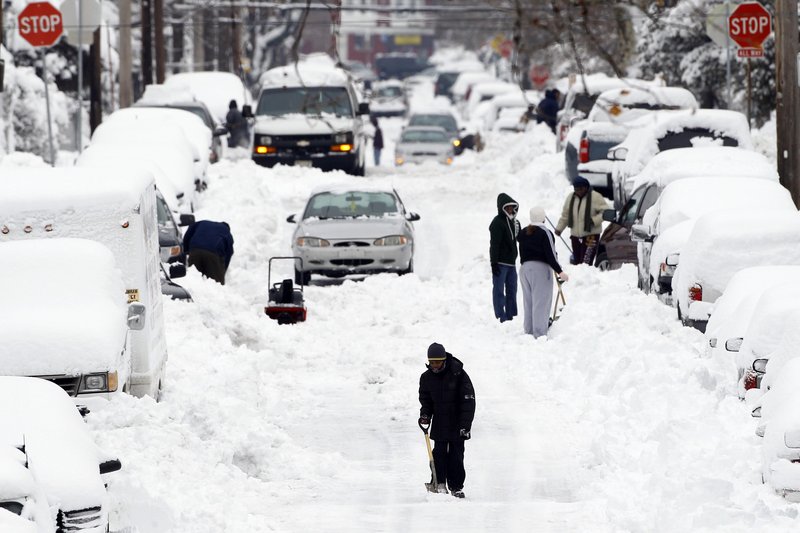WASHINGTON – Tree limbs snap, the power goes out, the car needs digging out again. Along with the grumbling about winter snow there’s also a common curiosity: So what does all this say about global warming?
How can the average world temperature be inching up and 2010 be tied for the warmest year ever, when places from North Carolina to New England get buried by whopper winter storms?
There are several scientific explanations that help sweep away the snow confusion.
But like everything else related to climate science, it’s all rather muffled these days, at least in the nation’s capital.
Those who don’t accept climate science are vocal. Some of those who do accept it think it’s better to talk about jobs or technology, rather than what’s going on with warming oceans and atmosphere.
Democratic pollster Douglas Schoen opined in The Washington Post after last winter’s big snowstorms in Washington that “the weather … makes it more difficult to argue that global warming is an imminent danger.”
President Obama, his Cabinet and Democrats in Congress who think it’s important to reduce emissions of heat-trapping gases from fossil fuels have talked about how transforming our use of energy can produce jobs. Climate change — which, along with dependency on fossil fuels, is the key reason for the transformation — gets almost no mention.
In the State of the Union speech, Obama never uttered the words “climate change” or “global warming.”
Scientists describe many effects of a warming climate if emissions continue unabated, and some of them have serious implications for fisheries, agriculture, habitation and health. But snow? Don’t throw the shovels out.
Weather Underground founder Jeff Masters explained on his WunderBlog last week that big snowstorms don’t indicate that global warming isn’t happening.
So far the global average temperature has warmed an average 1.5 degrees Fahrenheit since 1880, with bigger changes nearer the poles. And there’s even more warming still in the pipeline. “There will still be colder than average winters in a world that is experiencing warming, with plenty of opportunities for snow,” Masters wrote.
The latest report on climate change by federal scientists, “Global Climate Change Impacts in the U.S.,” said precipitation has increased by an average of about 5 percent in the past 50 years. It projects that northern areas generally will become wetter, and southern areas, especially in the West, will become drier.
Meanwhile, two current ocean and atmosphere patterns help explain winter cold and snow.
The climate phenomenon La Nina is linked to a cooling in sea-surface temperatures in the equatorial Pacific. Its opposite is El Nino, the warming of those waters.
La Nina is mainly responsible for this year’s weather patterns, said Ignatius Rigor, an atmospheric scientist at the Polar Science Center at the University of Washington.
La Nina was expected to bring more snow to the Pacific Northwest, much of the Upper Midwest and New England.
“Even in a warming world we will still have natural oscillations like day and night, winter and summer, and in this case El Nino and La Nina,” he said.
Another possible reason for colder winters and more snow is linked to the loss of Arctic sea ice and the effect that that change has on the winds that circle the North Pole.
In 2010, the extent of sea ice cover in the Arctic at its lowest point in September was 31 percent less than the 1979-2000 average. It was the third lowest year after 2007 and 2008.
Open water and water covered by thin ice allow heat stored in the ocean to escape to the atmosphere. The autumn release of heat weakens the winds that normally circle the North Pole and act as a fence keeping cold air in. When the circle of winds, the Polar Vortex, breaks down, cold air spills south.
James Overland, a National Oceanic and Atmospheric Administration scientist, described this Warm Arctic-Cold Continents pattern in a paper that was part of NOAA’s most recent Arctic Report Card.
Scientists have observed that the past five years have been the warmest period recorded in the Arctic. Last month, temperatures were unusually warm in areas that were ice-free in summer, including waters north of Alaska and in Greenland.
This year, for the second time in row, a warm Arctic is again influencing the Polar Vortex, allowing more cold wind to escape to the south and bringing cold to the U.S. East Coast, East-Central Asia and Europe.
In a recent paper, Overland wrote: “The conventional meteorologists’ view is that this breakdown is just random chaos. But given that the most extreme value occurred last year, there has been a major breakdown two years in a row, and that large changes are occurring in the Arctic, it is not inconceivable that warmer Arctic temperatures play some role in pushing toward a breakdown of the Polar Vortex in some years.”
Send questions/comments to the editors.



Success. Please wait for the page to reload. If the page does not reload within 5 seconds, please refresh the page.
Enter your email and password to access comments.
Hi, to comment on stories you must . This profile is in addition to your subscription and website login.
Already have a commenting profile? .
Invalid username/password.
Please check your email to confirm and complete your registration.
Only subscribers are eligible to post comments. Please subscribe or login first for digital access. Here’s why.
Use the form below to reset your password. When you've submitted your account email, we will send an email with a reset code.